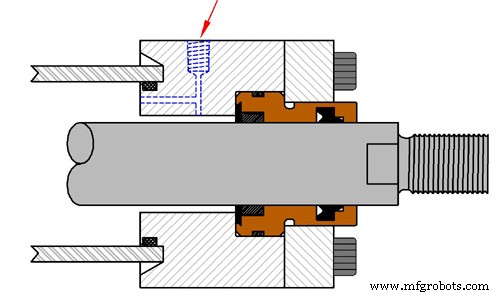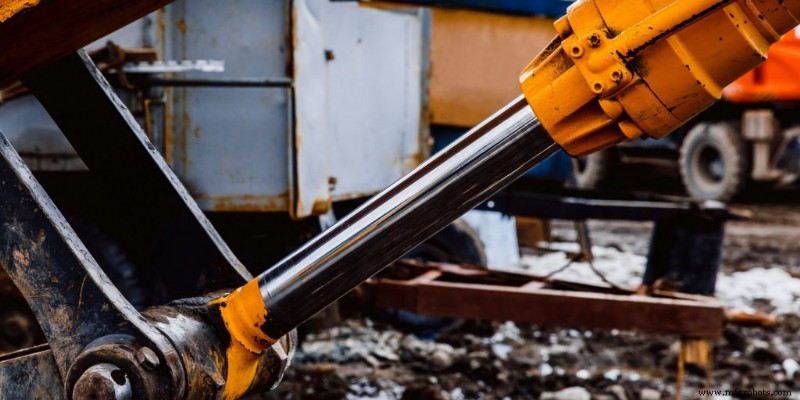Precisa sangrar cilindros hidráulicos?
Muitas pessoas acreditam que a sangria de cilindros hidráulicos é um trabalho necessário apenas quando algo dá errado e a bomba não pega. Mas este é realmente o caso? Neste artigo, veremos por que você pode precisar sangrar um cilindro hidráulico e o que o procedimento envolve.
O que são Cilindros Hidráulicos?
Os cilindros hidráulicos são usados em muitas aplicações, incluindo aeronaves, automóveis e máquinas agrícolas. Eles são feitos de uma série de tubos interconectados que pressurizam o líquido ou o gás para criar movimento.
Os cilindros hidráulicos são normalmente usados para alimentar dispositivos, como bombas, ventiladores e motores. Eles também podem ser usados para mover objetos ou fluidos de maneira controlada.
Cilindros hidráulicos vêm em uma variedade de tamanhos e formas. Eles geralmente são feitos de metal ou plástico. Eles podem ser unidades de um ou vários cilindros.
O que é a sangria de cilindros hidráulicos?
Se você estiver tendo problemas com seus cilindros hidráulicos, é importante sangrá-los. A sangria dos cilindros ajudará a liberar quaisquer detritos que possam estar bloqueando os pistões e as válvulas e restaurará os cilindros à sua condição de trabalho.

Tipos de Cilindros Hidráulicos de Sangria
A sangria dos cilindros hidráulicos é uma parte importante da manutenção do equipamento e para mantê-lo funcionando sem problemas. Existem alguns tipos diferentes de cilindros hidráulicos de sangria, por isso é importante saber qual deles você precisa sangrar.
O tipo mais comum de cilindro hidráulico de sangria é o tipo seringa. Este tipo de cilindro possui um êmbolo que se encaixa dentro de um encaixe na máquina. O êmbolo é empurrado para cima e para baixo e, quando atinge o fundo, o fluido é forçado a sair pelo encaixe e cair no chão. Este tipo de cilindro pode ser sangrado usando um sangrador de pressão ou um sangrador de vácuo.
O sangrador de pressão usa pressão de ar para empurrar o fluido para fora. Para usar este tipo de purgador, primeiro você precisa aumentar a pressão na máquina abrindo as válvulas de gás ou óleo. Em seguida, conecte o tubo sangrador à conexão da máquina e abra a válvula de sangria. Next, pressurize the bleeder tube by pumping air into it until the gauge reads 100 psi (pounds per square inch). Finally, close the bleed valve and wait until the gauge reads 0 psi before releasing the air pressure.
The vacuum bleeder uses suction to push the fluid out. Para
Why would you bleed hydraulic cylinders?
Most hydraulic systems use pressurized hydraulic fluid to operate the machinery. The hydraulic pressure is created when the liquid is forced through a valve and into a pipe. When the system needs to be repaired, it’s often necessary to bleed the hydraulic cylinders by draining off the pressure.
Bleeding the cylinders allows air and other contaminants to escape and prevents them from building up, potentially causing damage to the equipment or even a fire. It’s also important to bleed the cylinders regularly if you’re using synthetic oil or any other type of lubricant, as these will add volatility and pressure to the system.
Are there any risks to bleeding a hydraulic cylinder?
There are a few risks to bleeding hydraulic cylinders, but they are generally quite low. One potential risk is that the cylinder could rupture, resulting in severe injuries. Another risk is that the fluid could come out in a harmful or explosive manner. In either case, however, the likelihood of these risks occurring is very low.
How to Bleed a Hydraulic Cylinder
Bleeding hydraulic cylinders is an important step in maintaining hydraulic system performance. This procedure cleans and lubricates the components and helps prevent corrosion. To bleed a cylinder, you will need the following supplies:
-Cylinder
-Bleed screw
-Locknut
-Wrench
-Hose clamp
-Hydraulic fluid
-Container to store fluid (optional)
To bleed a cylinder, start by attaching the bleed screw to the cylinder head. Tighten the locknut until the bleeding is complete. If you are using a container to store fluid, attach the hose clamp to the container and connect it to the bleed screw. Turn on the hydraulic fluid and wait for the cylinder to fill with fluid. Once it has filled, turn off the hydraulic fluid and remove the bleed screw.
When to Bleed a Hydraulic Cylinder
If you are seeing hydraulic fluid leaking from your hydraulic cylinder, it is most likely time to bleed the system. Here are four reasons you may need to bleed a hydraulic cylinder:
-A bypass valve has been opened inadvertently, allowing fluid to escape from the cylinder and into the system.
-The cylinder seal has failed, allowing air and fluid to mix and create leaks.
-The piston has become stuck in the cylinder, preventing it from moving and creating a pressure build-up.
-The hydraulic system has been damaged in some way and needs to be repaired or replaced.

How to find the correct cylinder to bleed
There are a few things to keep in mind when bleeding hydraulic cylinders. The first is the type of cylinder you have. There are three types of hydraulic cylinders- internal, external, and mixed. Each has its own specificBleed procedure.
Internal cylinders can only be bled through the Schrader valve on the side of the cylinder. External cylinders have a bleed port on one end that can be used to bleed them, and they also have a Schrader valve on the other end. Mixed cylinders have both types of valves- one on each end.
The next thing to consider is the pressure rating of the cylinder. Most industrial applications require a pressure rating of at least 300 psi. If you’re not sure what your pressure rating is, check with your manufacturer or look it up online.
Now that you know some basics about bleeding hydraulic cylinders, it’s time to get started! Here’s a step-by-step guide to bleeding an internal cylinder:
1) Turn off the power to the machine and remove any stray objects that could get caught in the machinery.
2) Open the bleed port on the side of the cylinder (if applicable) and insert a suitable tube into
Conclusão
Bleeding hydraulic cylinders is a necessary task to keep your equipment in working order. However, it can be an extremely challenging and time-consuming process. In this article, we will discuss the different methods that are available for bleeding hydraulic cylinders and provide you with tips on how to successfully execute the task. We hope that this article will help make bleeding hydraulic cylinders a little bit easier for you.
Do you need to bleed hydraulic cylinders,please click topkitparts see more
Equipamento industrial
- Você precisa de novos freios de tempestade?
- O que são braçadeiras hidráulicas e por que você precisa delas?
- O que você precisa saber sobre freios auxiliares hidráulicos
- Guia de Seleção de Cilindros Hidráulicos
- Tudo o que você precisa saber sobre prensa hidráulica
- como sangrar uma bomba hidráulica
- Você precisa sangrar um sistema hidráulico?
- Como testar uma bomba hidráulica?
- Minha bomba hidráulica precisa de reparo?
- Os cilindros hidráulicos personalizados são adequados para você?



